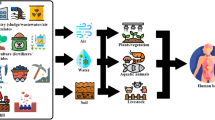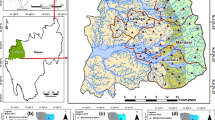Abstract
Geological and geochemical study has been carried out to investigate arsenic contamination in groundwater in Nawalparasi, the western Terai district of Nepal. The work carried out includes analyses of core sediments, provenance study by rare earth elements analyses, 14C dating, and water analyses. Results showed that distribution of the major and trace elements are not homogeneous in different grain size sediments. Geochemical characteristics and sediment assemblages of the arsenic contaminated (Nawalparasi) and uncontaminated (Bhairahawa) area have been compared. Geochemical compositions of sediments from both the areas are similar; however, water chemistry and sedimentary facies vary significantly. Extraction test of sediment samples showed significant leaching of arsenic and iron. Chemical reduction and contribution from organic matter could be a plausible explanation for the arsenic release in groundwater from the Terai sediments.








Similar content being viewed by others
References
Akai J, Kanekiyo A, Hishida N, Naganuma T, Fukuhara H, Anawar H (2003) Phyllogenetic and fatty acid analysis of bacteria to cause releasing of As from Bangladesh sediments in culture experiments. In: Proceedings of the 8th forum of arsenic contamination of groundwater in Asia, 22–24 Nov, Shimane University, Japan, pp 76–85
Ali M, Ishiga H, Wakatsuki T (2003) Distribution and changes in heavy metal contents of paddy soils in different physiographic units of Bangladesh sediments. Soil Sci Plant Nutr 49(4):527–538
Association for Environmental Measurement and Analysis in Japan (1995) The bottom sediment test methods manual. Environmental Agency Notification (46)
Bhatia MR, Crook KAW (1986) Trace element characteristics of graywackes and tectonic setting of sedimentary basins. Contrib Mineral Petrol 92:181–193
Condie KC (1993) Chemical composition and evolution of the upper continental crust: contrasting results from surface samples and shales. Chem Geol 104:1–37
Geen AV, Zheng Y, Versteeg R, Stute M, Horneman A, Dhar R, Steckler M, Gelman A, Small C, Ahsan H, Graziano JH, Hussain I, Ahmed KM (2003) Spatial variability of arsenic in 6000 tube wells in a 25 km2 areas of Bangladesh. Water Resour Res 39(5):1140
Hironaka H (2000) On site analysis of As3+ and As5+ by mercury bromide paper disk colorimetric method. In: Proceedings of the 5th forum on arsenic contamination of groundwater in Asia, Nov. 2000 Asia Arsenic Network (AAN), Yokohama, Japan, pp 111–112
Ishiga H, Dozen K, Yamazaki C, Ahmed F, Islam MB, Rahman MH, Sattar MA, Yamamoto H, Itoh K (2000) Geological constraints on arsenic contamination of groundwater in Bangladesh. In: Proceedings of the 5th forum of arsenic contamination of groundwater in Asia, Nov. 2000 Asia Arsenic Network (AAN), Yokohama, Japan, pp 53–62
Ito A, Takachi T, Kitada K, Aizawa J, Umita T (2001) Characteristics of arsenic elution from sewage sludge. Appl Organometal Chem 15:266–270
Kansakar DR (2004) Geologic and geomorphologic characteristics of arsenic contaminated groundwater areas in Terai, Nepal. In: Kansakar DR (ed) Arsenic testing and finalization of groundwater legislation project; summary project report, Lalitpur, Nepal. H. M. Govt. of Nepal, Dept of Irrigation, pp 31–47
Lengke MF, Tempel RN (2005) Geochemical modeling of arsenic sulfide oxidation kinetics in a mining environment. Geochim Cosmochim Acta 69(2):341–356
McArthur JM, Ravenscroft P, Safiullah S, Thirlwall MF (2001) Arsenic in groundwater: testing pollution mechanism for sedimentary aquifers in Bangladesh. Water Resour Res 37(1):109–117
Monsur MH (1995) An introduction to the Quaternary geology of Bangladesh, 1st edn. A complimentary research of IGCP 347 Quaternary stratigraphic correlation of the Ganges-Bramhaputra sediments, Dhaka, Bangladesh, pp 70
Musashino M (1990) The Panthalassa-a cerium-rich Atlantic type ocean: sedimentary environments of the Tamba Group, Southwest Japan. Tectonophysics 181:165–177
Nickson RT, McArthur JM, Ravenscroft P, Burgess WG, Ahmed KM (2000) Mechanism of arsenic release to groundwater, Bangladesh and West Bengal. Appl Geochem 15:403–413
Ogasawara M (1987) The trace element analysis of rock by X-ray fluorescence spectrometry, using Rh anode tube. Bull Geol Surv Jpn 38:57–68
Potts PJ, Tindle AG, Webb PC (1992) Geochemical reference material compositions. Whittles Publishing, Caithness, pp 313
Roser BP (2000) Whole-rock geochemical studies of clastic sedimentary suites. Mem Geol Soc Jpn 57:73–89
Sharma CK (1995) Shallow (phreatic) aquifers of Nepal, 1st edn. Sangeeta Publishing Kathmandu, Nepal, pp 272
Shrestha BR, Whitney JW, Shrestha KB (2004) The state of Arsenic in Nepal-2003. NASC/ENPHO Kathmandu, Nepal
Sinha R, Friend PF (1994) River systems and their flux, Indo-Gangetic plains, Northern Bihar, India. Sedimentology 41:825–845
Smedley PL, Kinniburgh DG (2002) A review of the source, behavior and distribution of arsenic in natural waters. Appl Geochem 17:517–568
Stuiver M, Reimer PJ, Bard E, Beck JW, Burr GS, Hughen KA, Kromer B, McCormac G, van der Plicht J, Spurk M (1998) INTCAL98 Radiocarbon Age Calibration, 24000–0 cal. BP Radiocarbon 40(3):1041–1083
Tanabe K, Yokota H, Hironaka H, Sachie T, Kubota Y (2001) Arsenic pollution of groundwater in Bangladesh. Appl Organometal Chem 15:241–251
Taylor SR, McLennan SM (1985) The continental crust: its composition and evolution. Blackwell, Oxford, pp 312
Torres ISI, Ishiga H (2003) Assessment of the geochemical conditions for the release of arsenic, iron copper into groundwater in the coastal aquifers at Yumigahama, Western Japan. In: Brebbia CA, Almorza D, Sales D (eds) Water pollution VII, modelling, measuring and prediction. WIT press, Southampton, pp 147–157
Tribovillard NP, Desprairies A, Verges EL, Bertrand P, Moureau N, Ramdani A, Ramanampisoa L (1994) Geochemical study of organic-matter rich cycles from the Kimmeridge Clay Formation of Yorkshire (UK): productivity versus anoxia. Palaeogeogr Palaeoclimatol Palaeoecol 108:165–181
UNDP and H.M. Govt. of Nepal (1989) Shallow groundwater investigation in Terai, Nawalparasi district (West). Tech Rep (5) pp 21
Williams V, Breit G, Whitney J, Yount J, Amatya SC (2004) Preliminary observations on the geology and geochemistry of arsenic-bearing sediments in Nawalparasi District, Nepal. In: Kansakar DR (ed) Arsenic testing and finalization of groundwater legislation project; summary project report, Lalitpur, Nepal. H. M. Govt. of Nepal, Dept. of Irrigation, pp 73–83
Yamazaki C, Ishiga H, Ahmed F, Itoh K, Suyama K, Yamamoto H (2003a) Vertical distribution of arsenic in Ganges Delta sediments in Deuli Village, Bangladesh. Soil Sci Plant Nutr 49(4):567–574
Yamazaki C, Itoh K, Higashi N, Ishiga H, Suyama K, Yamamoto H (2003b) Arsenic extractability with phosphate and citrate from peat collected in Bangladesh. Soil Sci Plant Nutr 49(6):859–865
Acknowledgements
We would like to thank the Monbukagakusho Japan for financial support and the Department of Irrigation (HMG) Nepal for logistical support during the field survey for this study. Thanks are also due to F. Ahmed and P.D. Ulak for their help with field work, to Mst. H. Bibi for her guidance on water analysis, and to Dr B.P. Roser for helpful comments on the manuscript.
Author information
Authors and Affiliations
Corresponding author
Rights and permissions
About this article
Cite this article
Gurung, J.K., Ishiga, H. & Khadka, M.S. Geological and geochemical examination of arsenic contamination in groundwater in the Holocene Terai Basin, Nepal. Environ Geol 49, 98–113 (2005). https://doi.org/10.1007/s00254-005-0063-6
Received:
Accepted:
Published:
Issue Date:
DOI: https://doi.org/10.1007/s00254-005-0063-6




